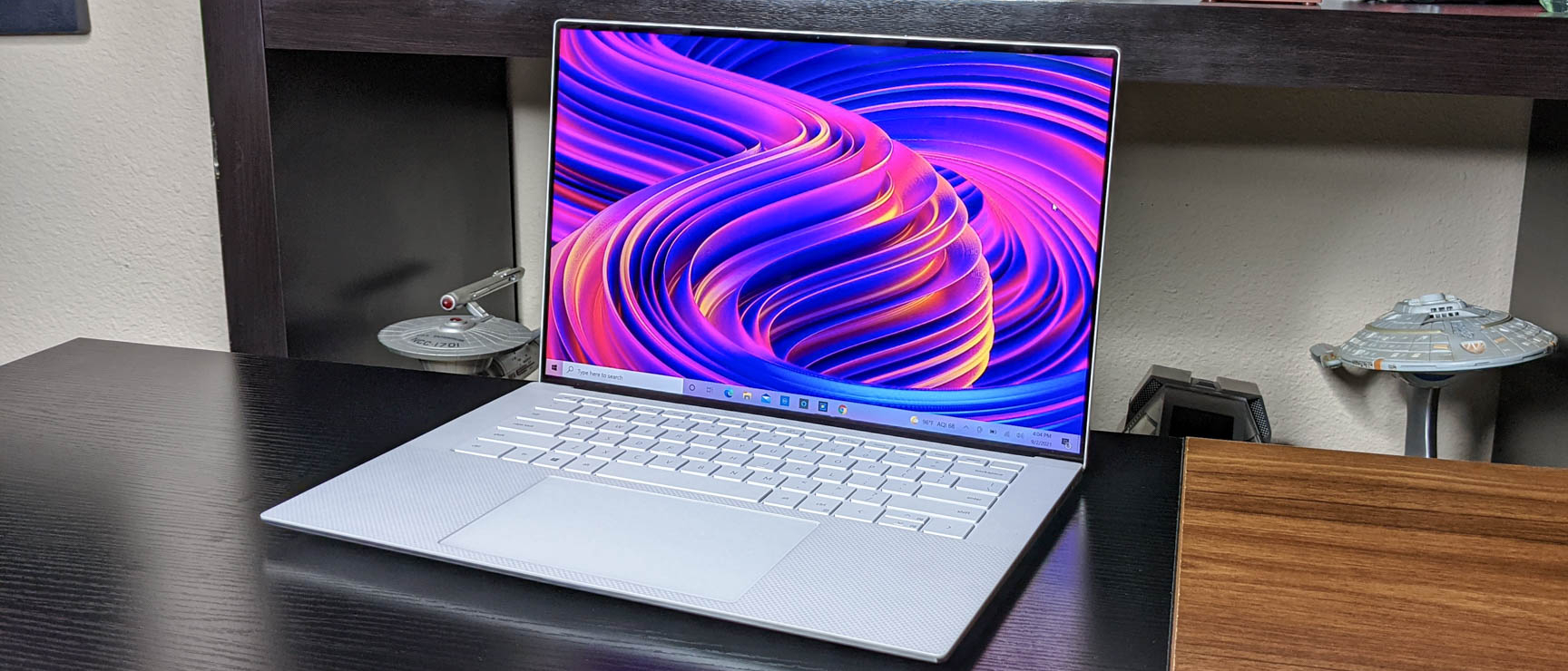Laptop Mag Verdict
Dell's XPS 15 OLED has a striking ultra-thin chassis with outstanding performance, powerful speakers and a massive touchpad. It's the ultimate 15-inch laptop for those willing to trade battery life for a mesmerizing 3.5K OLED display.
Pros
- +
Breathtaking 3.5K OLED display
- +
Supercharged performance
- +
Slim, premium chassis
- +
Massive touchpad and spacious keyboard
- +
Great speakers
- +
SD card slot and Thunderbolt 4 inputs
Cons
- -
Below-average battery life
- -
Heavier than some competitors
- -
No USB Type-A
Why you can trust Laptop Mag
Price: $1,299 ($2,401 as reviewed)
CPU: Intel Core i7-11800H
GPU: Nvidia GeForce RTX 3050 Ti
RAM: 16GB
Storage: 512GB M.2 PCIe NVMe SSD
Display: 15.6-inch, 3456 x 2160 (3.5K) OLED
Battery: 6:58
Connectivity: Wi-Fi 6, Bluetooth 5.1
Size: 13.6 x 9.1 x 0.7 inches
Weight: 4.3 pounds
In a way, the XPS 15 OLED (9510) is the laptop I've long-awaited. I purchased an XPS 15 in 2017 when it was the only true Windows alternative to the MacBook Pro, and it has been a reliable companion over the years. I've taken my XPS to tradeshows, slipped it into my carry-on during international flights, used it to edit countless photos for reviews, and even played some games on it.
The XPS 15 OLED is a better version of the laptop I've consistently praised over the past several years. It fixes past problems (remember the nosecam?) while refining every inch of the package. The highlight of this particular configuration is the stunning 3.5K OLED display with its jaw-dropping colors, contrast and brightness. It's a panel befitting of the XPS 15's stylish and portable design that blends a machined aluminum exterior with a woven pattern on the inside. On the deck are a gargantuan touchpad, spacious keyboard and powerful speakers.
But just as we saw with the XPS 13 OLED, opting for the high-end panel means trading in hours of battery life. It'd be tough to say goodbye to this display, but I'd ultimately go with the FHD+ screen for the extra endurance and lower price. And for me, upgrading to this new model would mean losing a USB-A port and relying on the included adapter, a compromise many are justifiably unwilling to make. Shortcomings aside, the XPS 15 OLED is one of the best video editing laptops and best 15-inch laptops around and worth its steep price.
Dell XPS 15 OLED price and configurations
If you're on a tight budget, the XPS 15 starts at $1,299, but you'll forgo some premium components. This base model has an FHD+ display along with a Core i5-11400H CPU, 8GB of RAM, a 256GB SSD and UHD graphics.
For whatever reason, Dell's online configurator makes you purchase a Core i7-11800H CPU, a 512GB SSD and an Nvidia GeForce RTX 3050 GPU when you upgrade to 16GB of RAM. Rather annoyingly, this raises the price to $1,899.
Our 3.5K OLED touchscreen model with a Core i7 CPU, 16GB of RAM, a 512GB SSD and RTX 3050 Ti graphics costs $2,401. However, as of writing, you can get the same config with a 1TB SSD for $2,400 at Best Buy. If you want to go wild, a $3,799 config comes with a 4K display, Core i9-11900H CPU, 64GB (!) of RAM, a 4TB SSD and an Nvidia GeForce RTX 3050 Ti GPU.
Dell XPS 15 OLED design
This is the Porsche of laptops — elegant, refined and precision-crafted.
Before making any comparisons to the MacBook Pro, let's set the record straight — this XPS 15 is no clone but a refinement of a design language Dell debuted years ago.
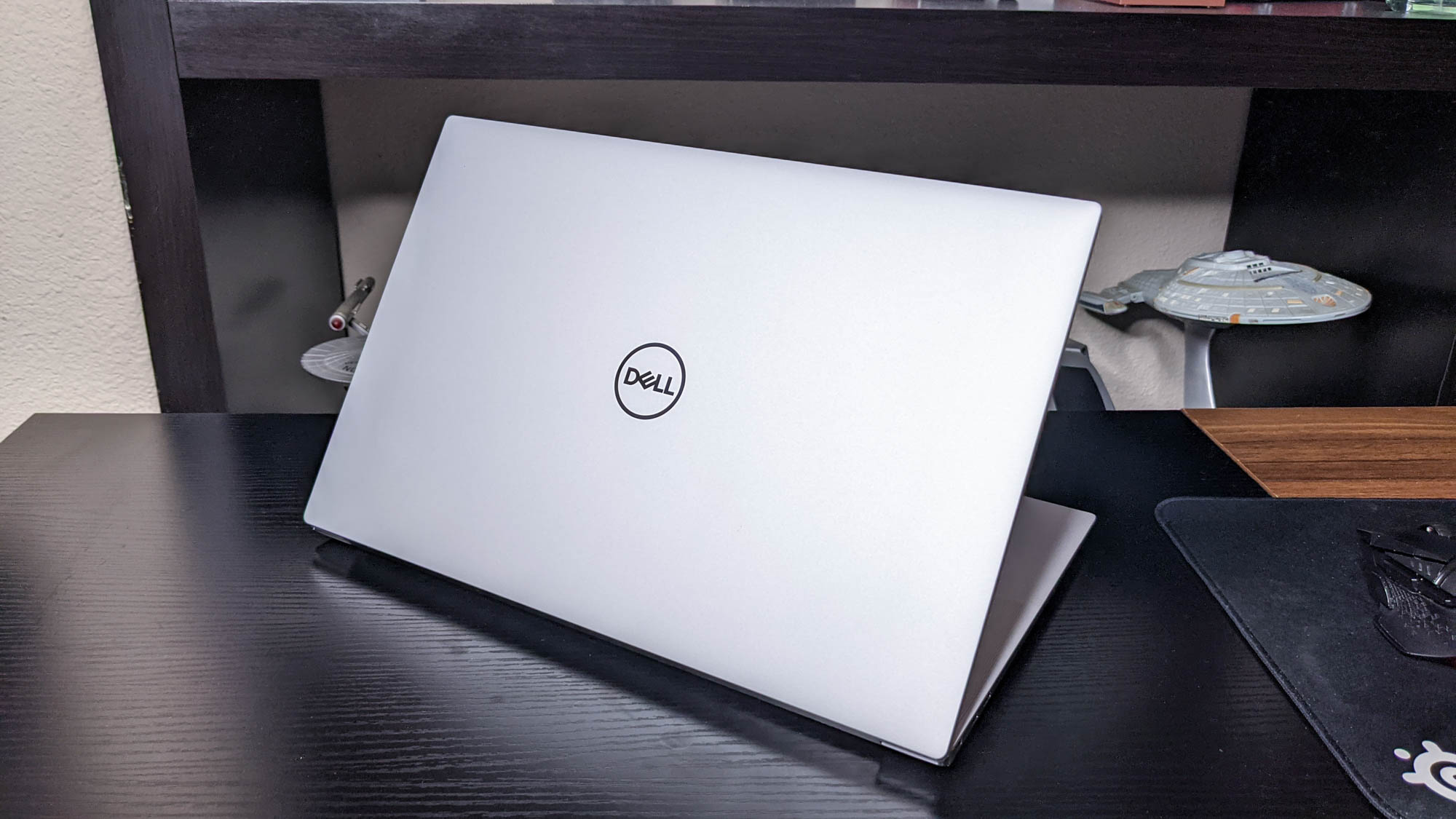
The thin slab of aluminum flaunts an attractive deck available in either soft-touch carbon fiber black or the snow-white weave on our unit. The Arctic finish has a subtle texture on the deck, and don't worry, coatings were applied to prevent this bleached surface from collecting dirt and smudges.
If Dell did take a page from Mac, it's with the XPS 15's gigantic touchpad, which takes up about half the length of the deck. Flanking the keyboard are grills for two top-firing tweeters, which pair with a set of woofers to deliver excellent audio quality (more on that below). The top-firing speakers were introduced in 2020, but what hasn't changed is the understated lid featuring a centered Dell logo in reflective dark chrome.
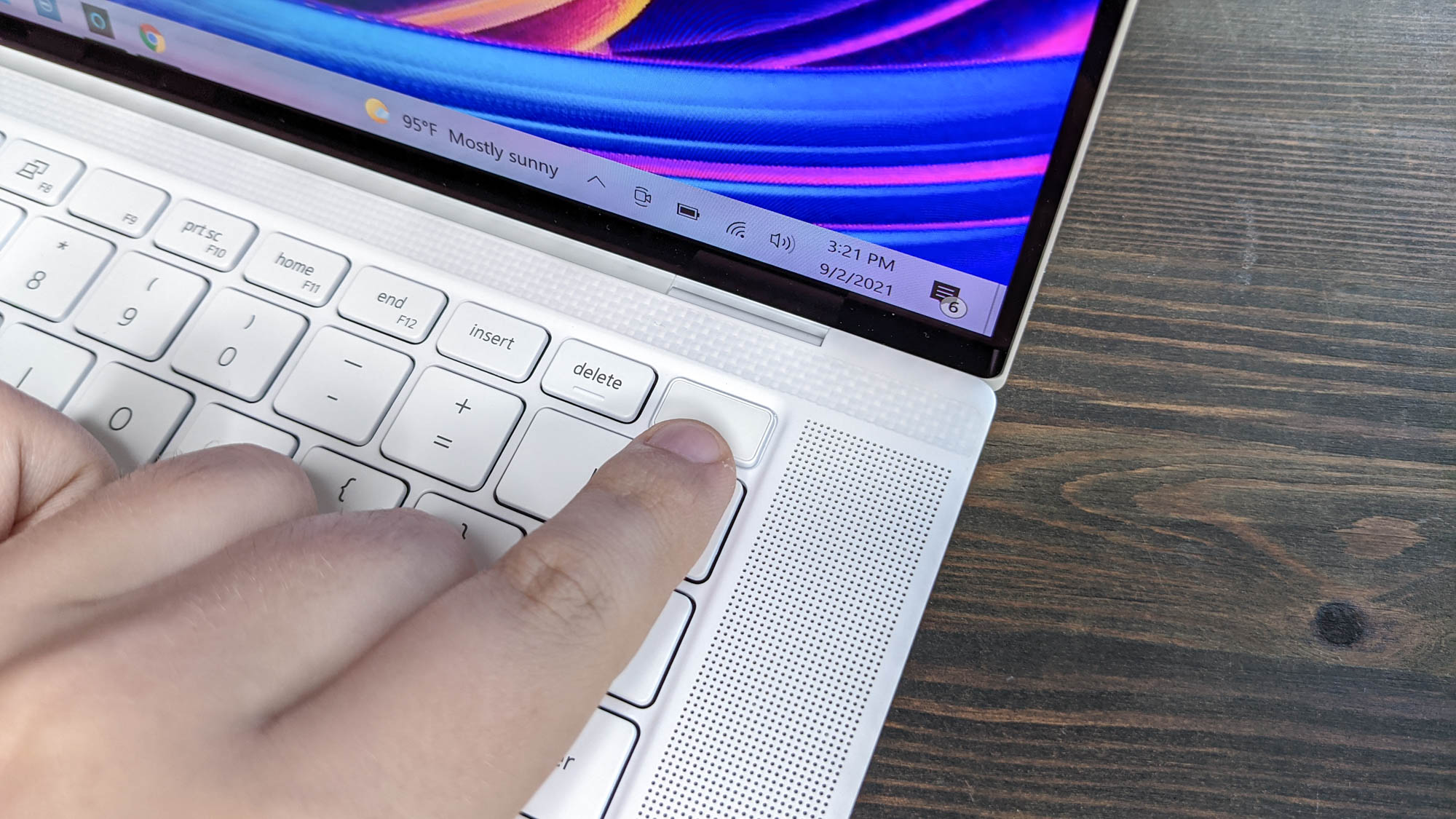
Dell started the thin-bezel trend years ago and it continues to do it better than any other company. Bordering the XPS 15's 15.6-inch display are the thinnest of frames — this laptop has a true edge-to-edge panel; no chin, no forehead. Other modern features include a fingerprint sensor embedded in the keyboard and an IR camera, both enable convenient and safe login.
The XPS 15 is an ultra-thin laptop, but don't mistake it for an ultra-lightweight model. Both the lid and undercarriage are made of solid machined aluminum, a material that gives the XPS 15 a uniquely premium aura at the expense of portability. Measuring 13.6 x 9.1 x 0.7 inches and weighing 4.3 pounds, the XPS 15 is lighter and thinner than the Asus ZenBook Pro Duo 15 (14.7 x 8.8 x 0.9 inches, 5.3 pounds) and the same size as the Razer Blade 15 Advanced Model (14 x 9.3 x 0.7 inches, 4.4 pounds). Despite having a 16-inch display, the MacBook Pro (14.1 x 9.7 x 0.6 inches, 4.3 pounds) is about as portable as the XPS 15.
What you trade in portability is gained in build quality. The XPS 15 is among the most airtight laptops I've reviewed. There is no flex on the keyboard or lid, you won't find any strange hairline gaps, and the hinge is stiff without requiring too much force to rotate.
Dell XPS 15 OLED ports
The XPS 15 is one of the few remaining laptops with a full SD card slot. But that godsend for photographers and videographers comes at the expense of a fourth USB-C port when you're comparing the XPS against the MacBook Pro.
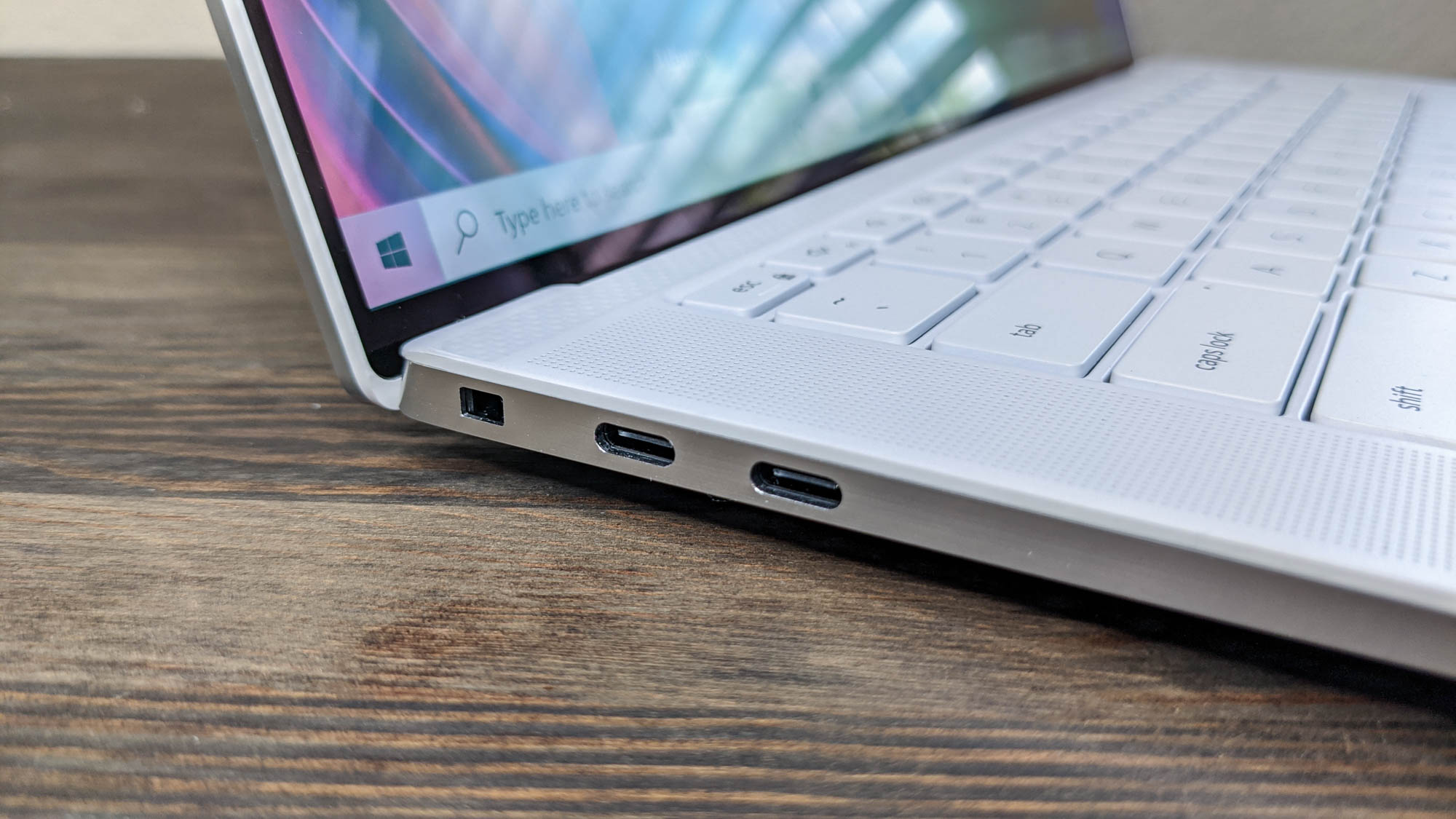
On the left side of the laptop, next to a lock slot, are two Thunderbolt 4 inputs for charging, connecting peripherals or transferring data. Flip to the right side and you'll find a USB 3.2 Type-C input alongside a full SD card slot and a headphone jack.
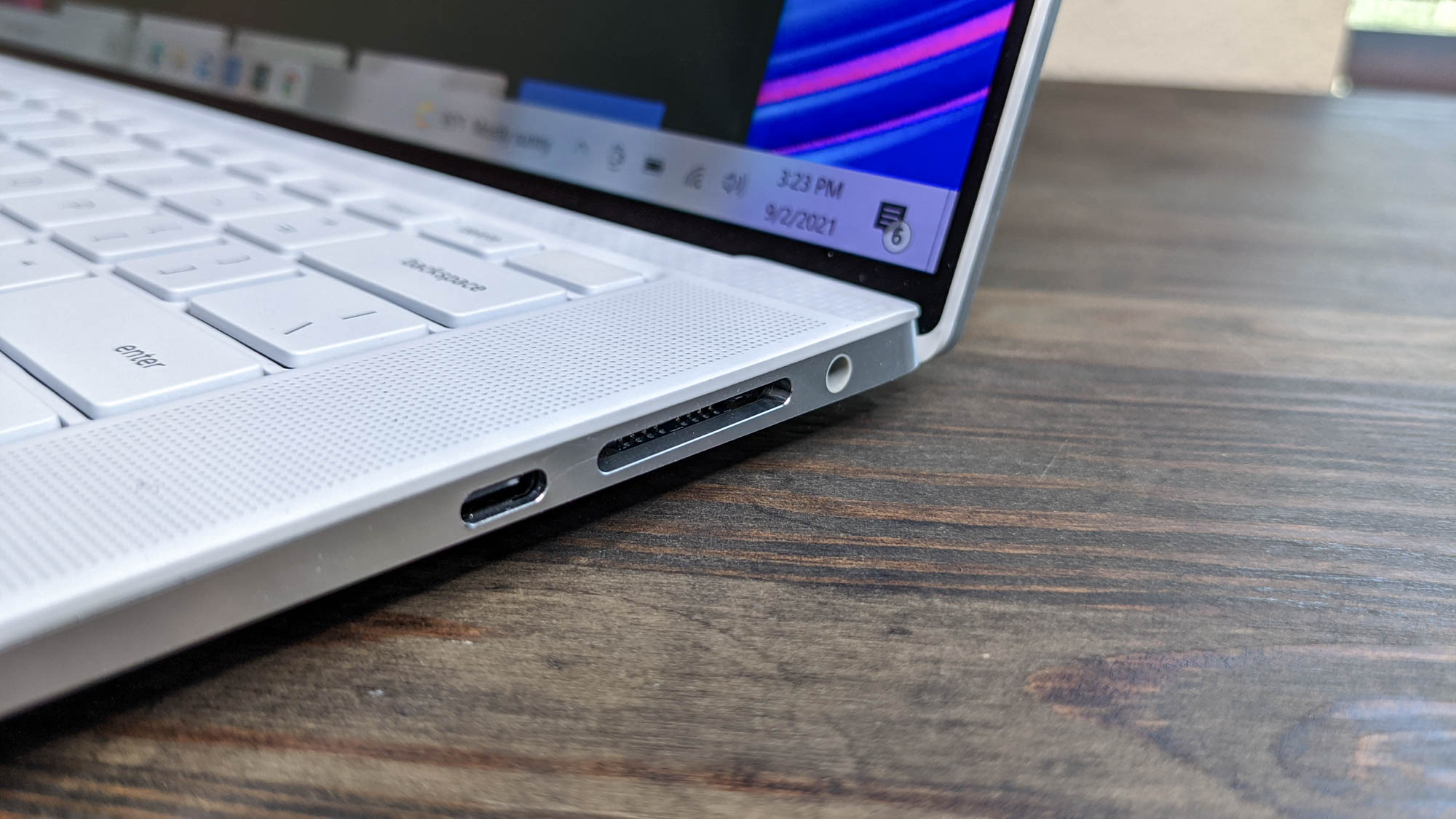
I'd take the card reader over a fourth Thunderbolt port (seriously Apple, who needs so many?). The glaring omission on both laptops is a USB Type-A input although Dell includes a USB-C-to-USB-A adapter as a consultation.
Dell XPS 15 OLED display
Have you ever stared mouth agape at the OLED TVs beaming vibrant colors from the back wall of your local electronics store? Now imagine one of those panels gracing you each time you open the lid of your laptop. I've had the XPS 15 OLED for a few days now, and I'm still entranced by the lock screen, home screen background, and other static interfaces I normally wouldn't pay any attention to. Everything looks better on the XPS 15's 15.6-inch, 3.5K (3456 x 2160-pixel) OLED touchscreen.
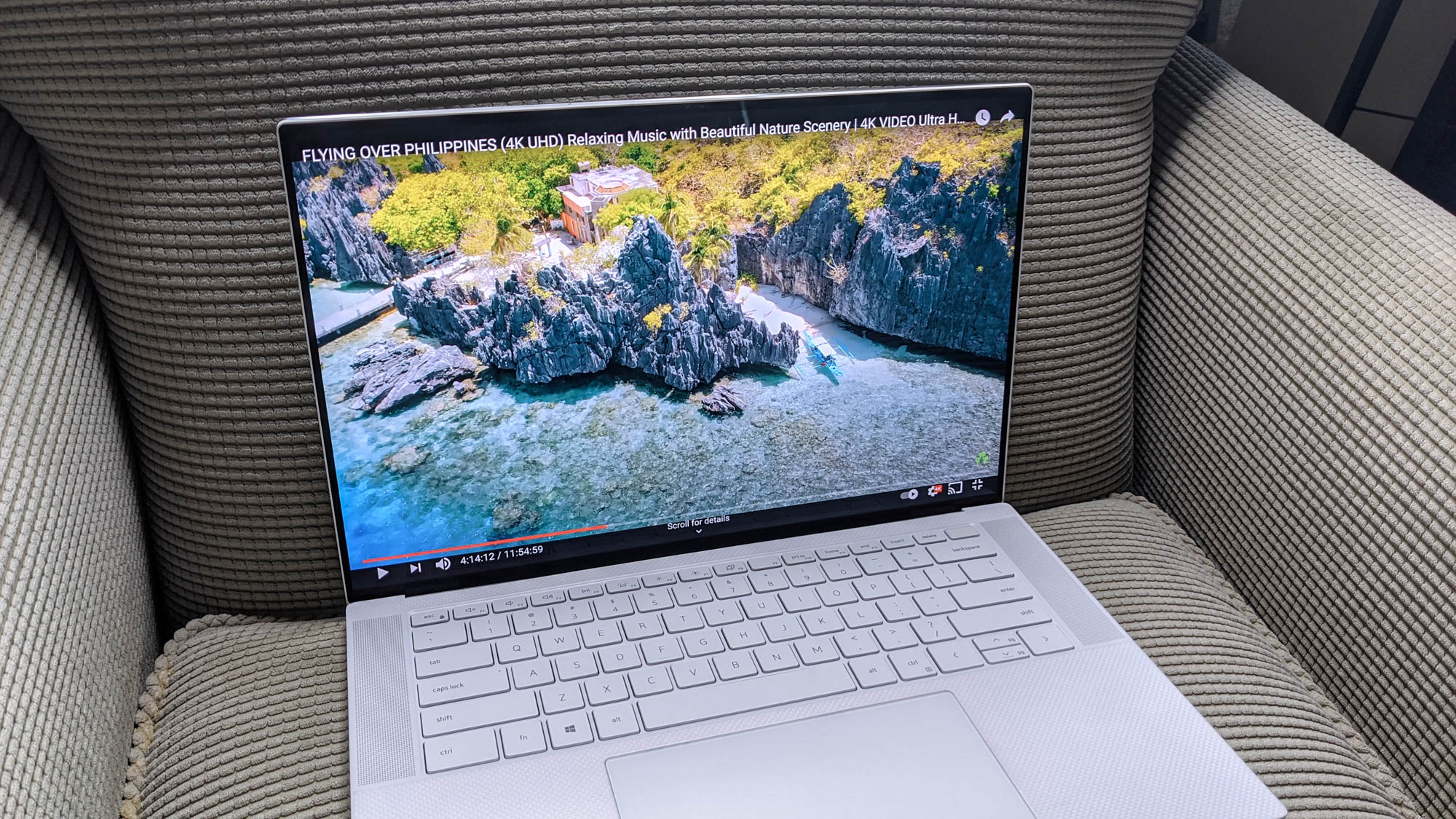
I couldn't get through this review without playing one of those 4K nature videos on YouTube. I landed in the Philippines where the ocean looked as blue as an aquamarine gemstone and the lush island foliage was every shade between orange and green. Adjusting the display presets in the Dell CinemaColor app had a marked impact on the image, with the Animation setting increasing contrast to the point of oversaturation. I found Movie mode to deliver the best balance between punchy and accurate colors.
If I owned this XPS 15, I'd skip the theater and watch No Time to Die once it arrives on streaming platforms. I say that because the 007 trailer looked magnificent on this screen. I didn't need to squint to see minute details, like a small cut on Bond's lip or the ridges in Safin's grotesque face. In each scene, Daniel Craig's sapphire blue eyes electrified the room, and the gorgeous scenery of Southern Italy made me yearn for the pre-pandemic days when travel wasn't such a risk.
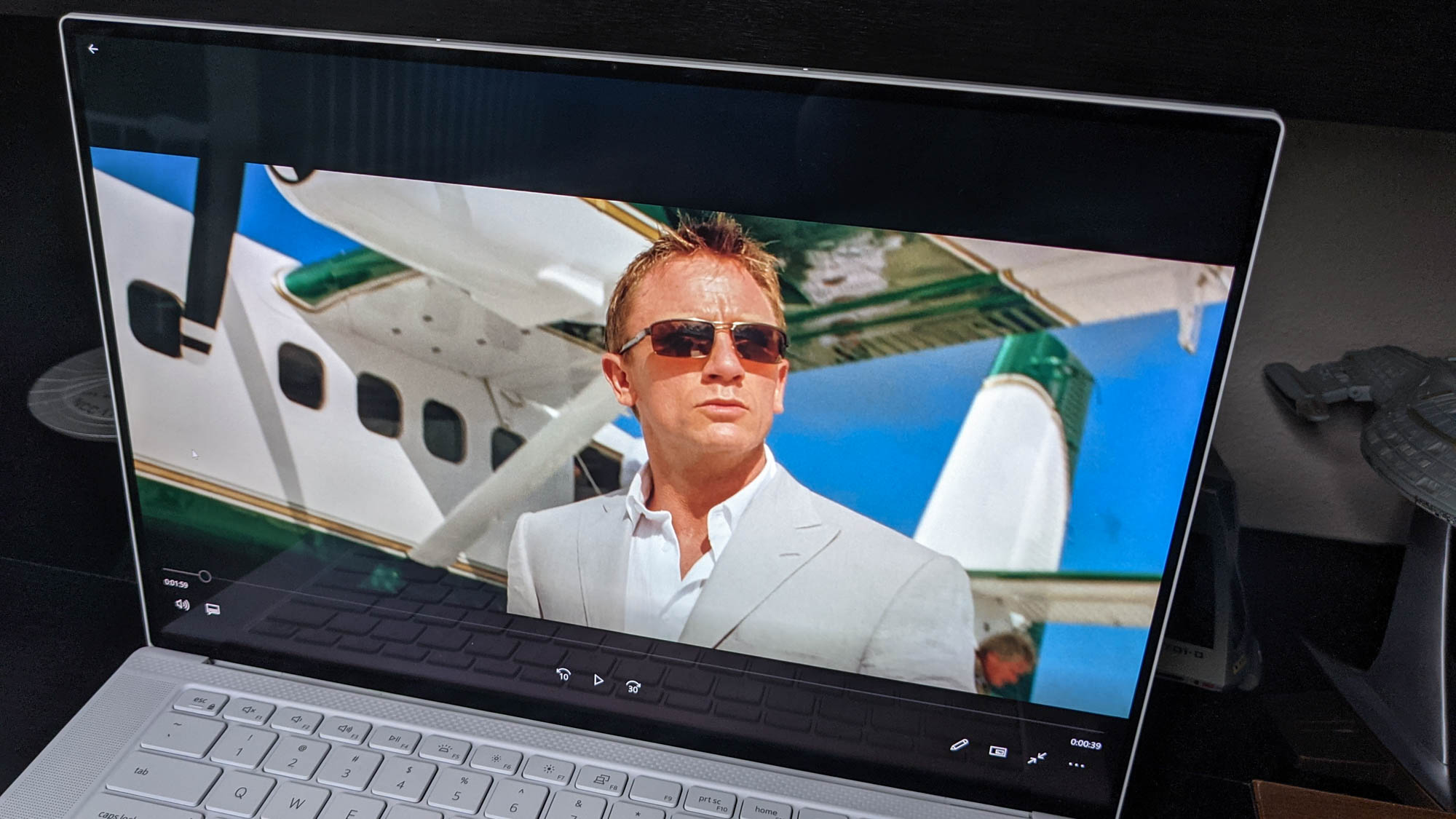
Don't pay too much attention to our display benchmarks because they don't tell the true story of this panel. According to our colorimeter, the XPS 15 OLED covered 85% of the DCI-P3 color gamut. That is a great result, topping the MacBook Pro (78%) and the premium laptop average (83%), but I expected it to be ahead of the Razer Blade 15 (89%) and much closer to the ZenBook Pro Duo 15's OLED panel (144%). For what it's worth, we saw similar results on the XPS 13 OLED (83%).
If there is a downside to OLED beyond the potential for burn-in, it's that these panels don't usually get very bright. That isn't the case with the XPS 15, which reached 398 nits and outshone the premium laptop average (382 nits). The XPS 15 was edged out by the ZenBook Pro Duo (422 nits) and the MacBook Pro (435 nits), but don't worry, you can easily use the Dell in bright conditions thanks to its exceptional contrast.
Dell XPS 15 OLED keyboard and touchpad
The keyboard is one of my least favorite things about this laptop; it’s unexceptional. Maybe my expectations are too high because of how damn good the rest of this notebook is, but this just doesn't do it for me. While not particularly shallow, the keys don't have much of a tactile click and, as a result, feel somewhat squishy.
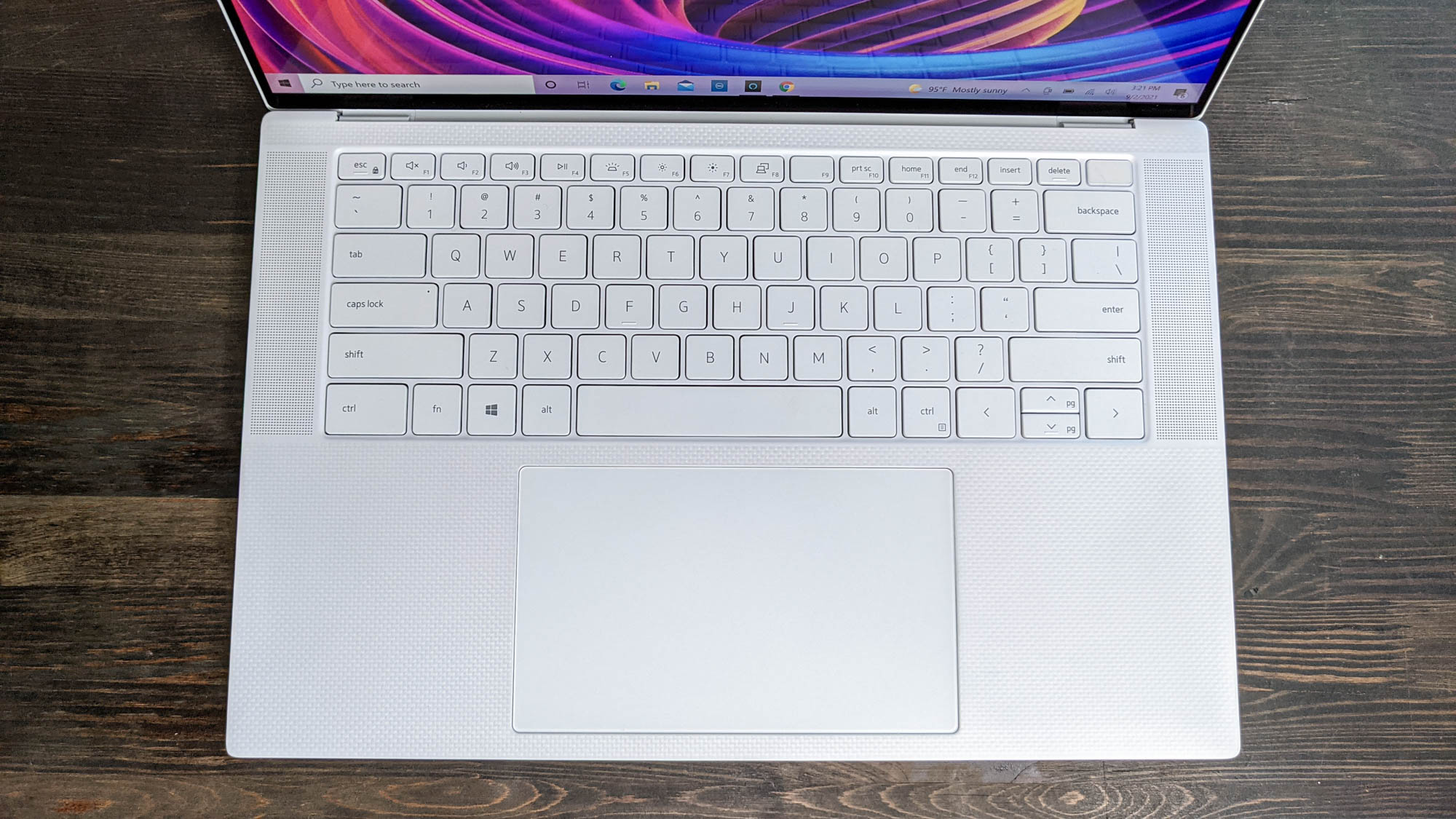
This isn't a deal-breaker, by any means. The keys are responsive and their low actuation force means your fingers can quickly skip from one to the next. In fact, I found myself typing faster on this XPS than on my mechanical keyboard — my fingers just weren't as comfortable. Those with big hands will appreciate the size of this keyboard though Dell needs to be careful here — any larger and I'd struggle to reach the esc and backspace buttons without lifting my hand. Also worth pointing out is how the white backlighting against the white keycap paint can make letters and numbers difficult to see if you're a hunt-and-peck typist.
On the 10fastfingers.com test, I typed at 118 words per minute with a 96% accuracy, both of which topped my usual 109-wpm with a 5% error rate. There is a disclaimer attached to these scores: my personal laptop of three years is an XPS 15 so my fingers are already molded to the layout.

Let me emphasize: this touchpad is enormous. My palms brushed the top of the surface when my fingers were on the home row; fortunately, the touchpad is smart enough to prevent accidental swipes. Navigating the cursor on the XPS 15 evoked the feeling of running my hands down silk curtains; the satiny glass-coated surface reacted to my rapid movements and Windows 10 gestures, like pinch-to-zoom and three-finger swipes, registered instantly.
Dell XPS 15 OLED audio
Excuse the colloquialism, but these speakers are bumpin'. I instinctively bobbed my head to Slenderbodies' "superpowerful" when the chorus erupted into a flurry of electric guitar twangs and drum beats interlacing smooth, powerful vocals. Each instrument in this complex tune had its own position in the soundstage; I could hear the finger snaps behind the electric guitar plucks and hushed falsettos.
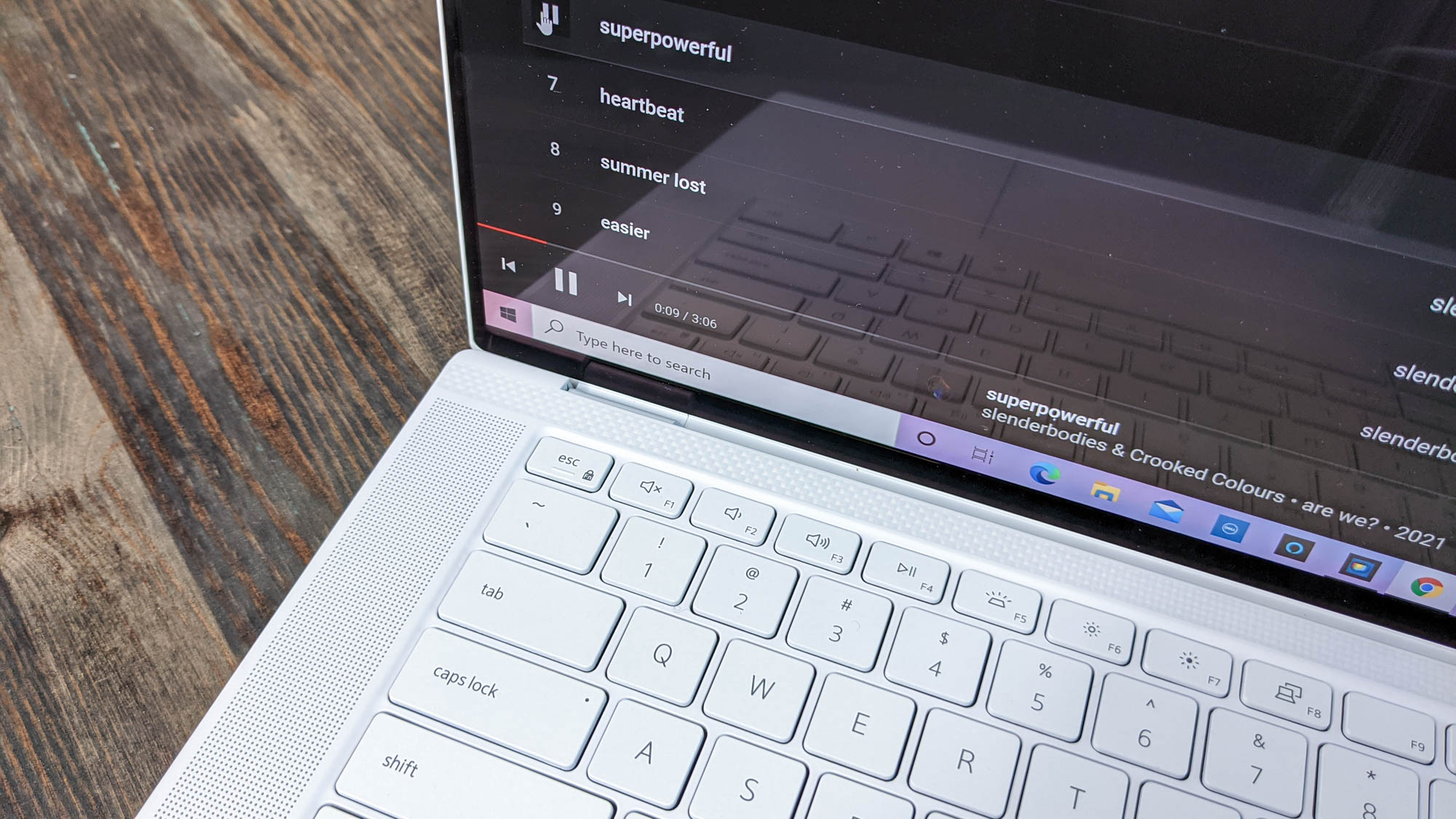
I threw the speakers a curveball with The Killers' "Mr. Brightside," a song that typically devolves into a cacophony of loud noises on most laptops I test. That wasn't the case on the XPS 15, which put the vocals at the forefront and expertly separated the overlapping guitar twangs. Those who own an older XPS 15 should take solace in knowing the sound quality on this latest model is transformatively better.
I was never hip enough to host a college party, but I'll go out on a limb and say the XPS 15's quad speakers are powerful enough to blast clear, dynamic music through your dorm hall. So, against our usual advice, skip the computer speakers and use your laptop to jam out.
Dell XPS 15 OLED performance
The XPS 15 is like the climbers at my local bouldering gym. It may look lean on the outside, but any problem can be solved when the muscles are flexed. On the XPS 15, those muscles are a Core i7-11800H CPU with 16GB of RAM — powerful components that shrugged when I opened 35 Google Chrome tabs, four of which played 1080p YouTube videos. I then streamed a World Cup qualifier between Germany and Liechtenstein without experiencing a hint of lag.
On the Geekbench 5.4 overall performance benchmark, the XPS 15 reached an outstanding 7,477, which tops the ZenBook Pro Duo 15 (7,028) and smoked the Razer Blade 15 Advanced (6,531). How much faster is the XPS than others in this category? The average score for premium laptops is 4,789. Oh, and the MacBook Pro with the M1 chip? It topped out at 7,306.
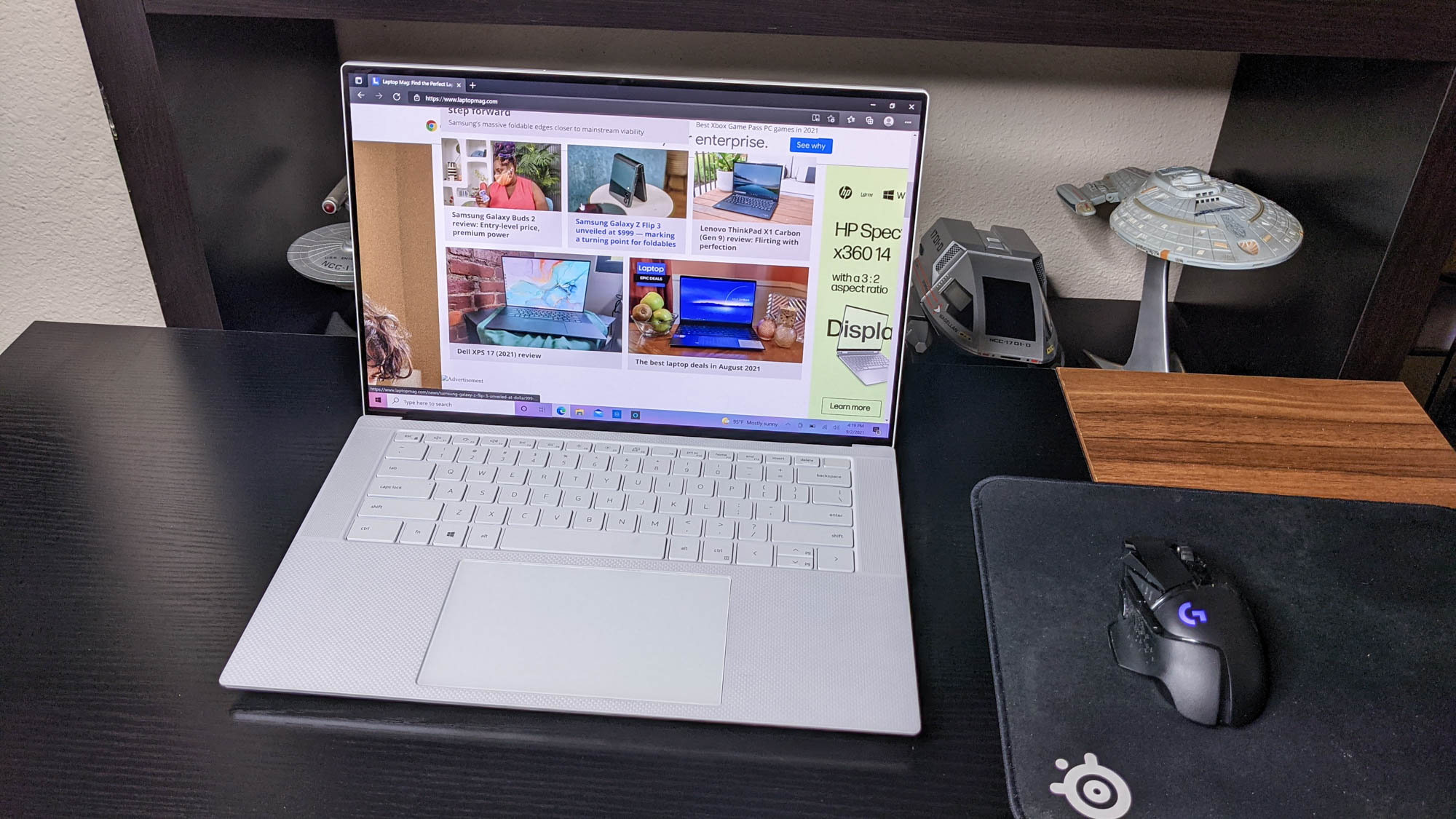
It took the XPS 15 OLED only 8 minutes and 10 seconds to convert a 4K video to 1080p resolution using the Handbrake app. The ZenBook Pro Duo 15 needed another seven seconds while the premium laptop average (15:07) is nowhere near these powerhouses. Apple fans win a small victory here with the MacBook Pro with M1 completing this task in 7:44.
Speedy storage rounds out an excellent performance package; the 512GB M.2 PCIe NVMe SSD in our review unit took 33 seconds to duplicate a 25GB multimedia file for an 825.6 megabytes per second transfer rate. It beat the premium average (868.7 MBps) and the Blade 15 (890.2 MBps) but the ZenBook Pro Duo (950.1 MBps, RTX 3070) was a bit quicker and the MacBook Pro (2,754 MBps) is still king.
Dell XPS 15 OLED graphics
Ultraportable by day, gaming rig by night. With its Nvidia GeForce RTX 3050 Ti GPU, the XPS 15 can double as a gaming laptop so long as you don't need to play at 4K on Ultra.
When we ran the Sid Meier's Civilization VI: Gathering Storm benchmark, the XPS 15 notched 67 frames per second at 1080p and 42 fps at native 3.5K resolution. The MacBook Pro, which relies on integrated M1 graphics, sputtered to just 29 fps.
On synthetic tests, the XPS 15 scored 8,433, ahead of the premium laptop average (5,411) but predictably behind the ZenBook Pro Duo.
Dell XPS 15 OLED battery life
With its 3.5K OLED panel and discrete graphics card, the XPS 15 faced an uphill battle in our Laptop Mag Battery Test. So I wasn't surprised when the laptop clocked out after just 6 hours and 58 minutes.
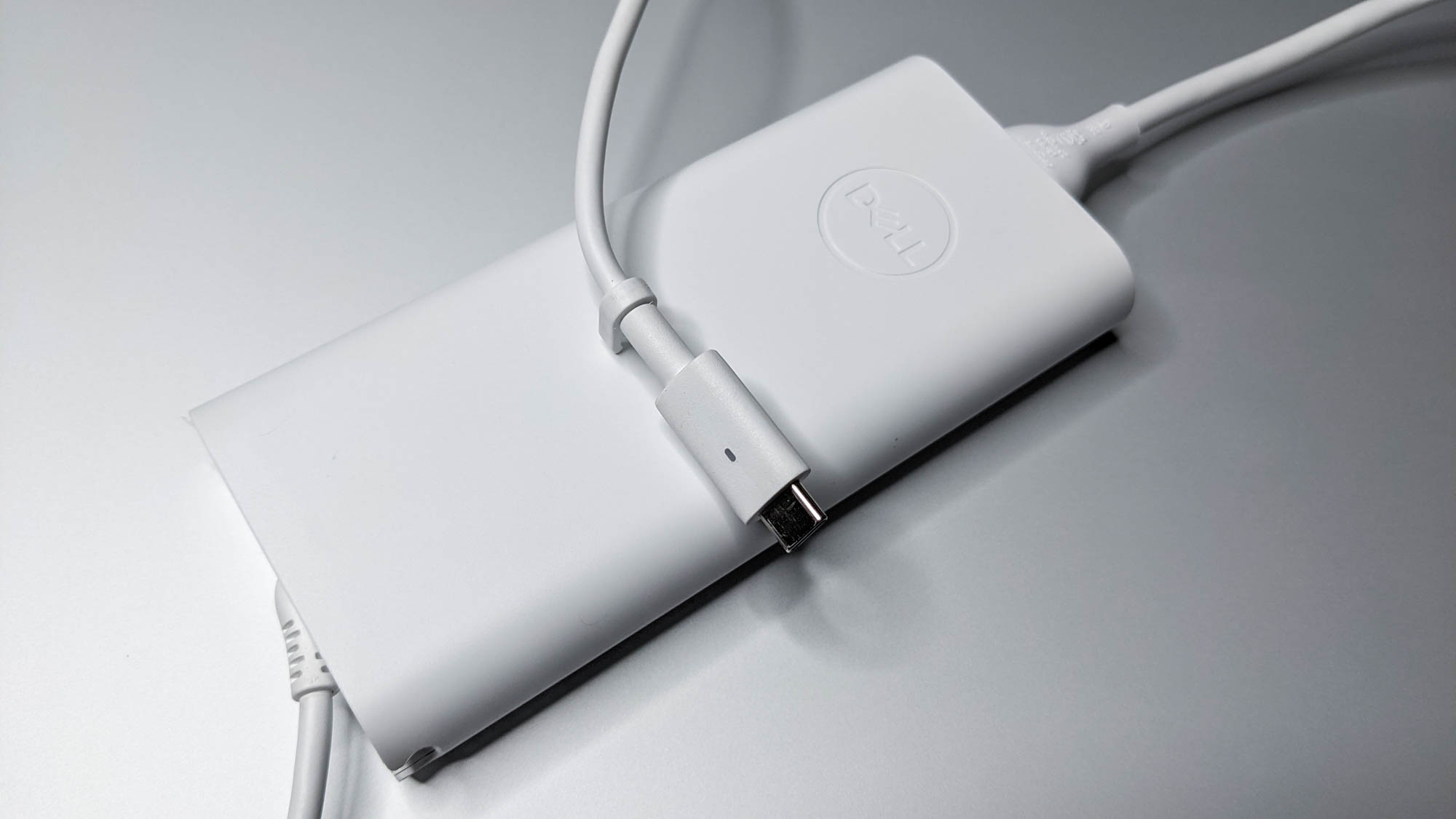
Seven hours isn't a terrible result for this decked-out configuration, but an extra hour or two would've provided some reassurance to those who work away from an outlet. But even then, the XPS would fall short of the premium laptop average (10:33) and the 16-inch MacBook Pro (10:55). That much is expected given the lower-res panels on these competitors — the XPS 15, to its credit, outlasted the ZenBook Pro Duo 15 (6:50) with its 4K screen.
Dell XPS 15 OLED webcam
The XPS 15 has one of the better 720p webcams I've tested. And while that isn't saying much, a selfie I snapped in my dimly lit room looked surprisingly clear. Even with its low-res camera, the XPS captured fine details in my face, like stray hairs I failed to comb before they set and the subtle gradient in my shirt. Colors were accurate with my face ranging from Texas-tanned brown to the red underlining my eyes, evidence that sleep hasn't come easy during this pandemic.

This is an adequate webcam, but I'll continue to advocate for 1080p resolution. If you need the best video quality for those important conference calls, an external webcam is a worthwhile investment.
Dell XPS 15 OLED heat
With heat dispersed across its large metal undercarriage, the XPS 15 never caught a fever. In fact, it warmed only to the average human body temperature of 98 degrees Fahrenheit after we played a 15-minute, 1080p video. That is slightly above our 95-degree comfort threshold, but nothing to be too concerned about. Better yet, the keyboard and touchpad reached only 92 and 75 degrees, respectively.
Dell XPS 15 OLED software and warranty
A single do-it-all program instead of the eight separate Dell-branded apps on the XPS 15 would've been appreciated — but at least this clutter is useful. The self-explanatory Dell Update is where you'll get the latest BIOS updates and drivers while Dell Power Manager shows your battery health and lets you change thermal settings.
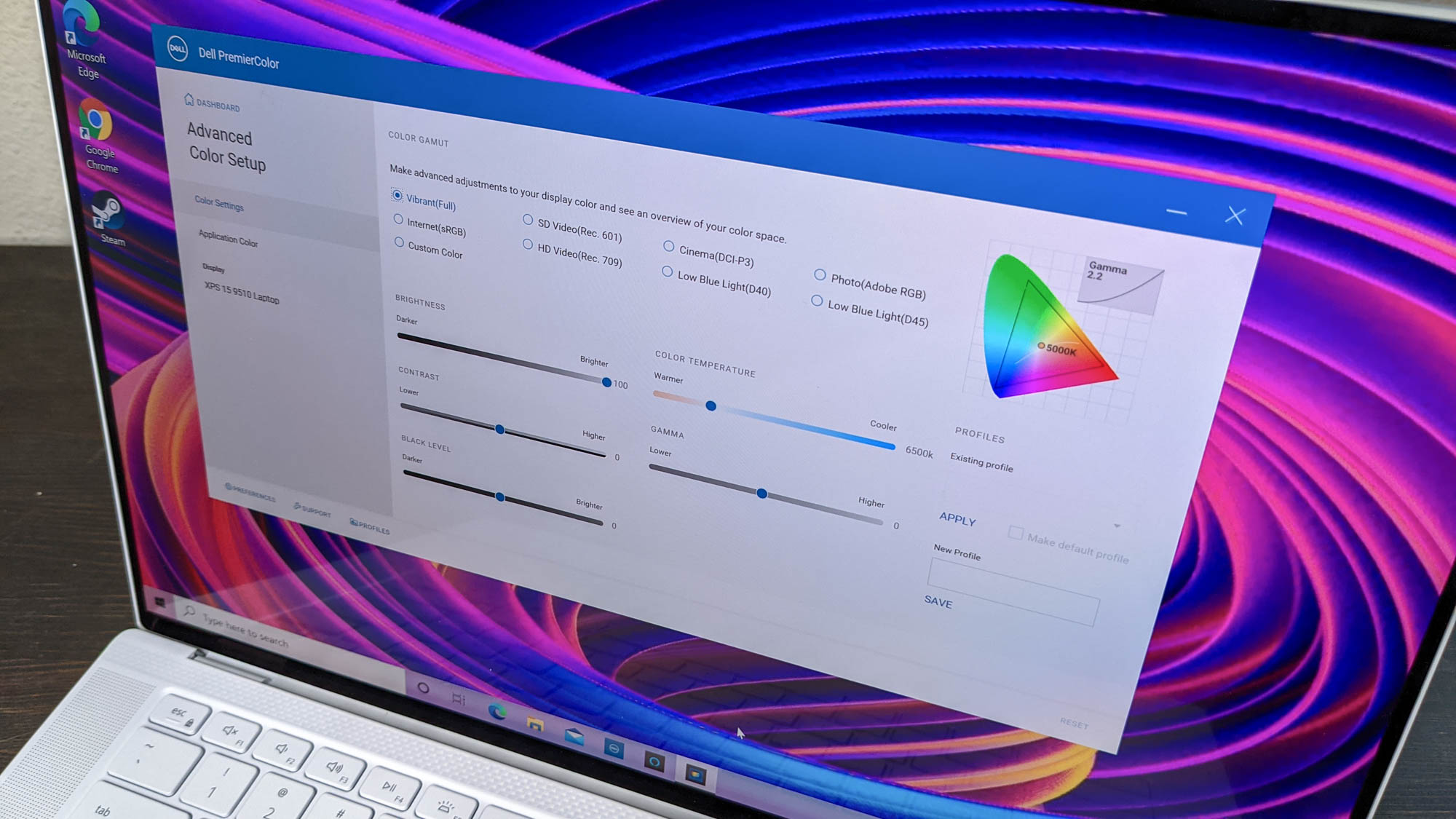
Dell CinemaColor is important on this OLED panel as it lets you choose between color profiles. Movie mode produces punchy yet accurate colors, Night mode saves your eyes, Sports ensures smooth motion, and animation boosts the colors to ridiculous saturation levels. For more granular controls, Dell PremiereColor provides professional calibration settings for sRGB, Rec. 601 and other standards. You can even manually calibrate the display so long as you own a colorimeter.
Also worth highlighting is Dell Cinema Guide. It's a beautiful app where you can find TV shows and movies then quickly see which streaming apps they're available on.
The XPS 15 comes with a one-year warranty. See how Dell fared on our Tech Support Showdown and Best and Worst Brands special reports.
Bottom line
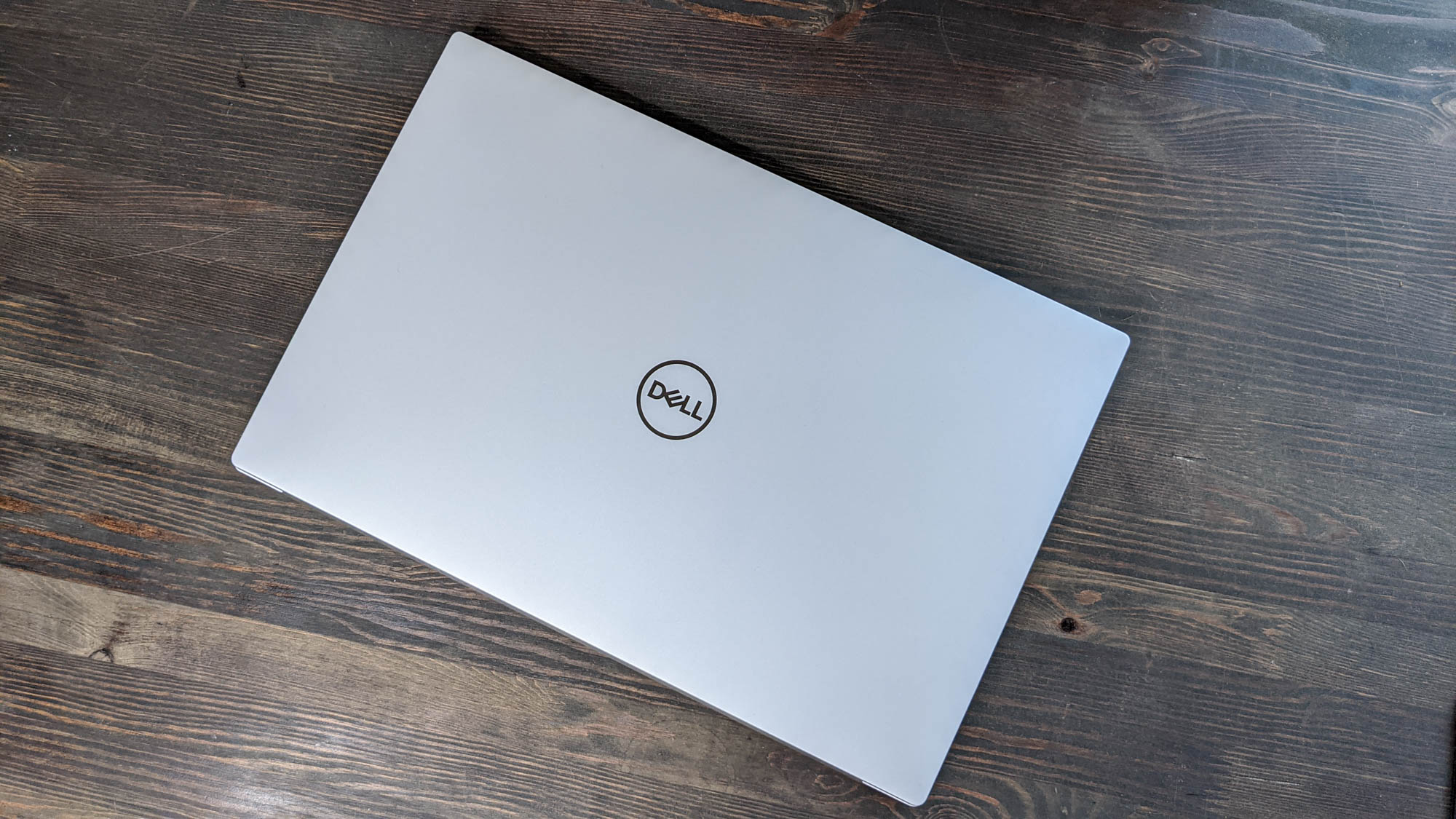
The XPS 15 OLED is the best Windows laptop for power users who need to take their work (or play) on the road. Its attractive design screams luxe, the OLED display is stunning, and the oversized touchpad would impress even a MacBook user. Combine those XPS staples with excellent performance from 11th Gen Intel and Nvidia RTX 3050 Ti chips and it's easy to recommend this machine to students, business users or content creators, like photographers, videographers or graphics designers.
But let me pause my praise because this isn't the model I'd recommend to most people. For one, it's expensive. And while the 3.5K OLED panel is marvelous, seven hours of runtime isn't enough to get you through a full day. Dell tends to use top-rate 1920 x 1200-pixel panels, so I recommend that anyone who cares about battery life opt for the FHD+ display.
Would I, the pleased owner of a three-year-old XPS 15, upgrade to the latest version? I have no doubts it would suit my needs. However, the market is more competitive today than it was just a few years ago. I'd consider lighter options like the Lenovo ThinkPad X1 Carbon or more flexible 2-in-1 laptops like the HP Spectre x360 14 before committing.
As for the inevitable comparison, the XPS 15 is a better choice than the current 16-inch MacBook Pro, a laptop I wouldn't suggest to anyone given the imminent launch of a new version with a custom Apple chip. We'll compare this XPS 15 with the new 16-inch MacBook Pro once it arrives. Until then, those on the market for a portable laptop with a large screen can do no better than the XPS 15.
Phillip Tracy is the assistant managing editor at Laptop Mag where he reviews laptops, phones and other gadgets while covering the latest industry news. After graduating with a journalism degree from the University of Texas at Austin, Phillip became a tech reporter at the Daily Dot. There, he wrote reviews for a range of gadgets and covered everything from social media trends to cybersecurity. Prior to that, he wrote for RCR Wireless News covering 5G and IoT. When he's not tinkering with devices, you can find Phillip playing video games, reading, traveling or watching soccer.
